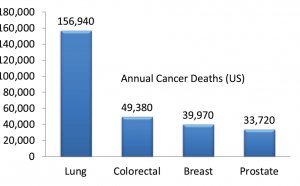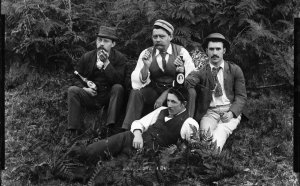
History of lung cancer
“Lung cancer continues to be the leading cause of death in both men and women in the US, with over 158, 900 deaths in 1999. Worldwide, lung cancer kills over 1 million people a year. Extensive prospective epidemiologic data clearly establish cigarette smoking as the major cause of lung cancer. It is estimated that about 90% of male lung cancer deaths and 75–80% of lung cancer deaths in the US are caused by smoking each year” (Hecht, 1999). Clearly, lung cancer is an important and widespread disease that constitutes a major public health problem. This was not always so. Some 150 years ago, it was an extremely rare disease. In 1878, malignant lung tumors represented only 1% of all cancers seen at autopsy in the Institute of Pathology of the University of Dresden in Germany. By 1918, the percentage had risen to almost 10% and by 1927 to more than 14%. In the 1930 edition of the authoritative Springer Handbook of Special Pathology it was duly noted that malignant lung tumors had begun to increase at the turn of the century and perhaps even more so after World War I and that, possibly, they still were on the increase. It was also noted that while most lung tumors occurred in men, there seemed to be a steady increase in women. Duration of the disease, from being recognized until death, was usually from half a year to 2 years and in practically all cases there had been a long history of chronic bronchitis.
What caused such a dramatic increase in an obscure disease? The handbook discusses at some length possible etiologic factors: increased air pollution by gases and dusts, caused by industry; the asphalting of roads; the increase in automobile traffic; exposure to gas in World War I; the influenza pandemic of 1918; and working with benzene or gasoline. However, lung cancer rose at the same rate in countries with fewer automobiles, less industry, fewer paved roads, and in workers not exposed to benzene or gasoline—and had not risen in the 19th century after earlier flu pandemics. In 1 or 2 sentences, smoking was briefly mentioned as another possibility, but it was pointed out that as many investigations failed to show an association between smoking and lung cancer as there were positive findings. In summary, there was some suspicion, but by no means certainty that lung cancer would be caused by extraneous agents and no particular importance was given to the smoking of cigarettes. It is interesting to note, however, that in 1929 (presumably too late to be included in the handbook) the German physician, Fritz Lickint published a paper in which he showed that lung cancer patients were particularly likely to be smokers. He then went on a crusade against smoking, and antitobacco activism actually became widespread in Germany.
VIDEO REVIEWS
![[PDF] A History of Lung Cancer: The Recalcitrant Disease](/img/video/pdf_a_history_of_lung_cancer.jpg)


Share this Post
Related posts
What is the History of lung cancer?
(Regarding this and Timmermann s previous book, with Elizabeth Toon, Cancer Patients, Cancer Pathways: Historical and Social…
Read MoreHistory of Copenhagen tobacco
A Canadian Can of Copenhagen Long Cut. Copenhagen is a brand of smokeless tobacco made by the U.S. Smokeless Tobacco Company…
Read More










